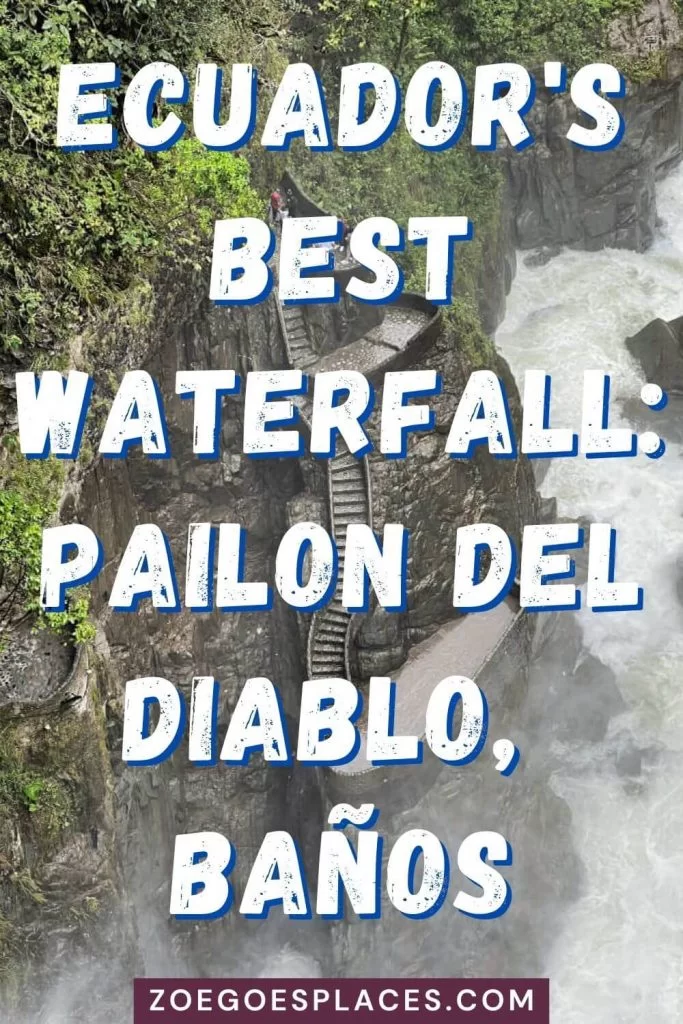Cascada El Pailón del Diablo Baños is easily the most impressive waterfall in Ecuador and one of the best in all of South America! Be sure to add this gem to your itinerary when you’re in this part of the world to have your mind blown!
Find out all you need to know to visit Diablo Waterfall Baños including entrance cost, how to get there, what to expect and how to find the entrance – it’s not as simple as it sounds! Plus, learn more about this cool attraction, its unique ecosystem and where to get the best photos.
If you’re planning a trip to Ecuador now or in the future, keep reading and get ready to add this amazing waterfall to your bucket list…
Some of the links below are affiliate links, meaning, at no additional cost to you, I may earn a small commission if you click through and make a qualifying purchase.
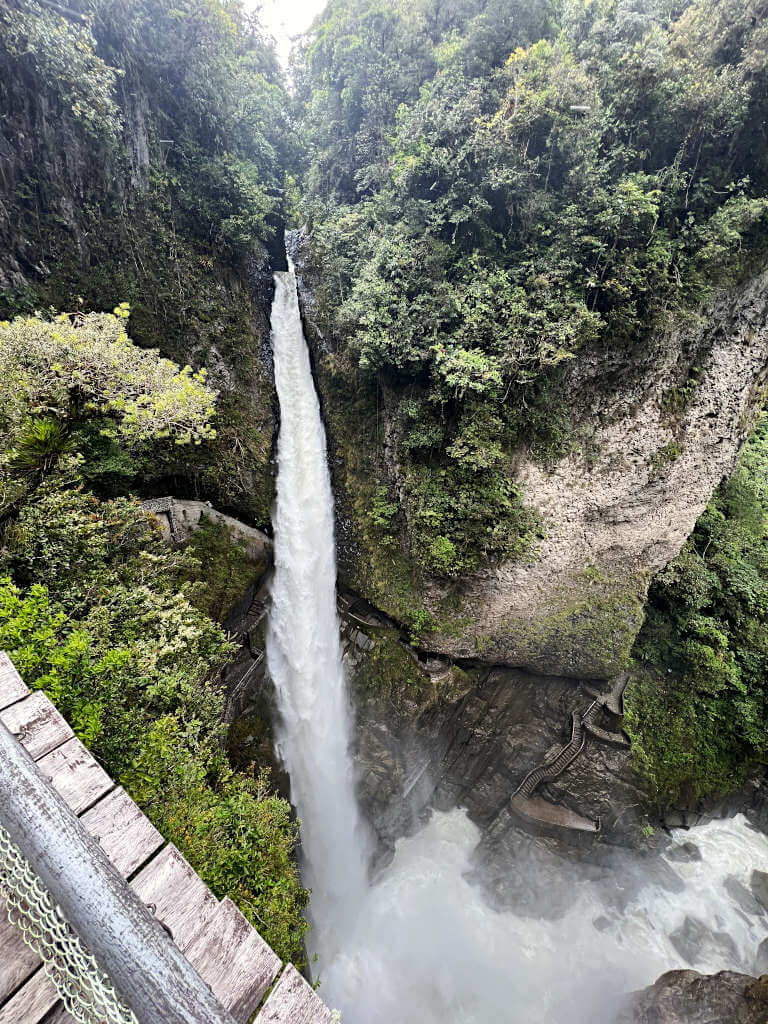
Where is El Pailón del Diablo Waterfall Ecuador?
The waterfall is located east of the Ecuadorian city of Baños de Agua Santa (or more commonly, just Baños) in Río Verde. Additionally, the waterfall is situated on the impressive Rio Pastaza. Impressive because, despite starting less than 200 km from the Pacific coast, the water actually flows east into the Marañón and Amazon rivers, before reaching the Atlantic Ocean!
Furthermore, the Diablo Waterfall is part of Baños’ famous Ruta de las Cascadas (Route of the Waterfalls in English). This collection of Baños waterfalls located along the Pastaza River makes for a great day trip from the city. Diablo is typically the last visited waterfall on the route.
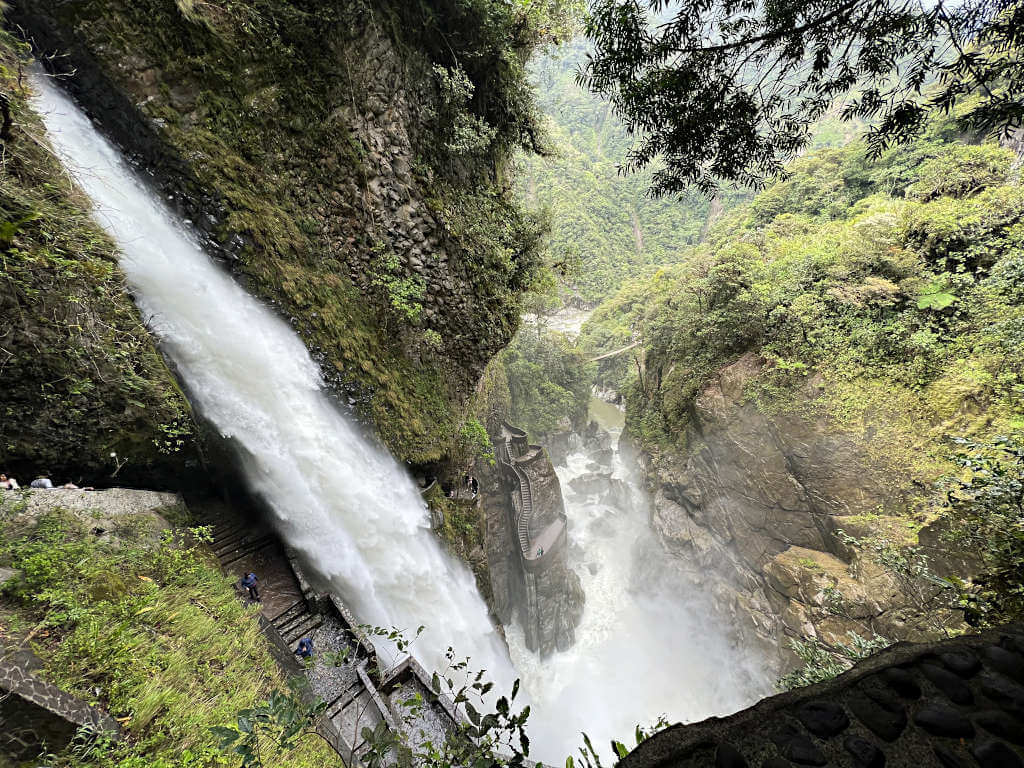
Why is it called Pailón del Diablo?
The name of the waterfall translates as the Devil’s Cauldron. The cauldron part comes from the large enclosed gorge that the waterfall sits in. And, the devil part is – apparently – because you can see the shape of a skull in the rock face. Can’t say I’ve seen it myself, but who am I to doubt legend?!
how tall is Pailón del diablo Baños?
The waterfall is an impressive 80 metres tall (265 feet) with a pool depth of 20 metres (65 feet).
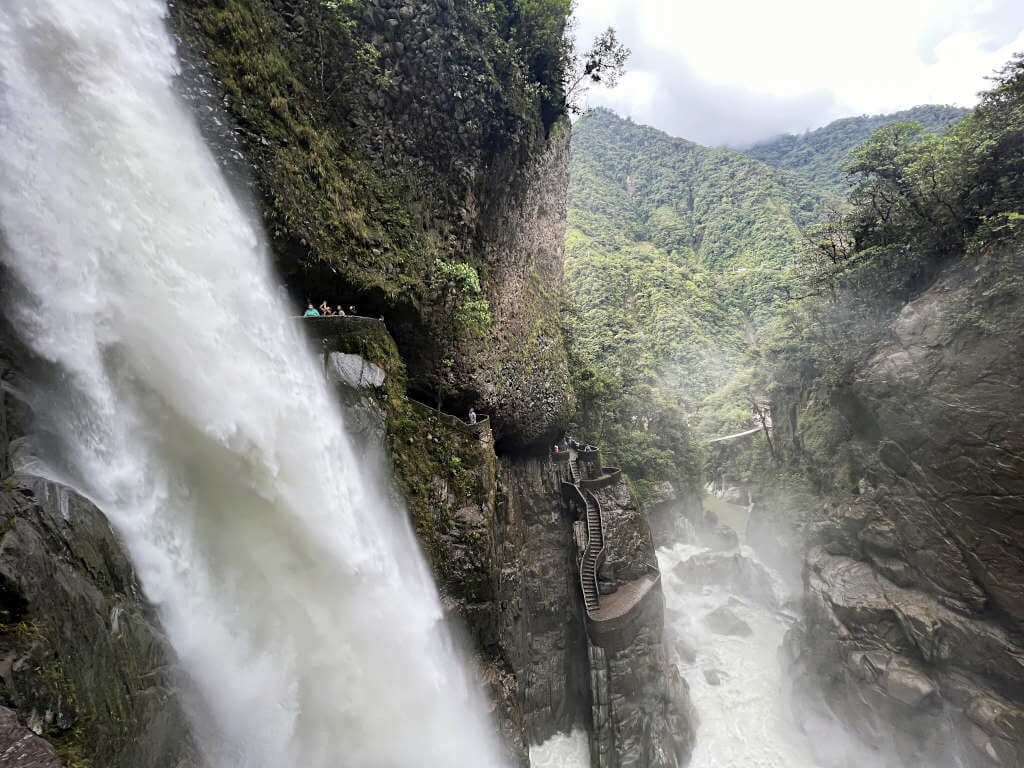
Is El Pailón del diablo Ecuador Man Made?
No, but of course the surrounding viewing platforms and steps are. Honestly, I had my doubts when I saw how perfectly the rocks at the top were shaped, but I guess they don’t call it the 8th Wonder of the World for nothing!
More Facts about Diablo Waterfall Baños
- The first walking routes to the waterfall were only built in 1994. Before this, access to the waterfall was limited and mostly viewed from afar.
- The waterfall has a unique and exotic ecosystem, the entrance fee for visiting the waterfall goes towards preserving the precious flora and fauna that grow.
- There is no cable car to provide a bird’s eye view of the impressive cascada because the owners believe that the walk is good for people’s health. Plus, the noise and movement would disturb the wildlife native to the area.
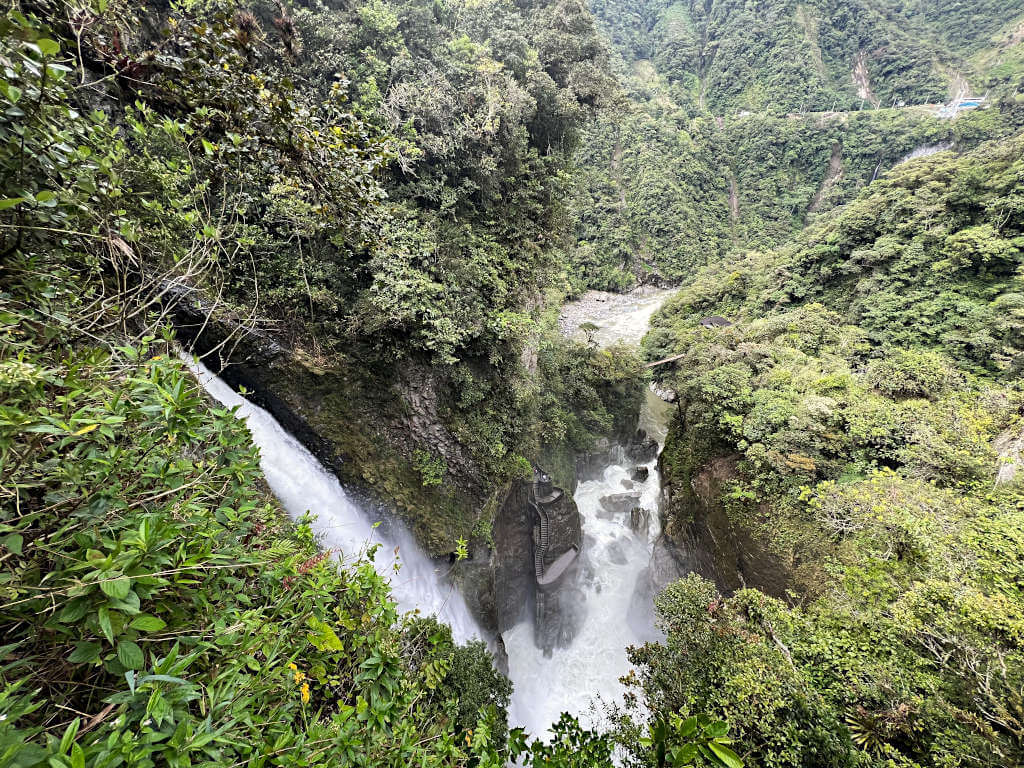
Visiting Devil’s Cauldron Waterfall
Here’s everything you need to know to plan your visit to Ecuador’s best and most well-known waterfall!
Diablo Waterfall Entrance Fee
During the day, the entrance fee is 2 USD for adults and 1 USD for children. The cost is the same for Ecuadorian nationals and international visitors.
The waterfall is open from 9 am to 10.30 pm, on Mondays to Thursdays. Then from Friday to Sunday, it is open from 8.30 am to 11 pm. After dark, the entrance fee increases to 4 USD for adults and 2 USD for children. See more on visiting Diablo Waterfall at night in the section below.
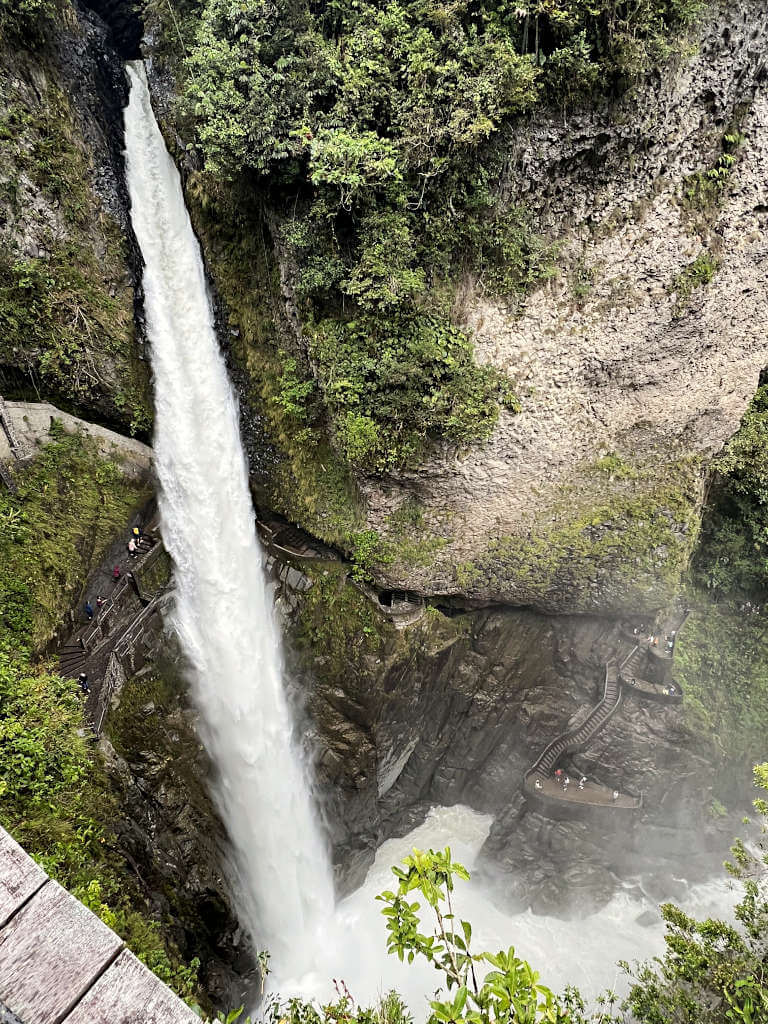
The two Entrances
The most confusing thing about visiting El Pailón del Diablo Waterfall Ecuador is that there are two separate entrances. And, each one has a completely different view! And, when you arrive in the town, the staff will just try to get you to their entrance without explaining the options.
The first option is called the New Entrance (or Nueva Entrada in Spanish). This is the one where you get to look over the iconic steps in the rocks from a small viewing platform.
The second option is the longer walking route. And, with this one, you’ll end up on the famous steps themselves and up close to the waterfall on a series of viewing platforms.
Unfortunately, the two sections are not linked despite both passing close to each other behind the waterfall. As such, you have to choose one entrance – unless you want to pay twice to visit both.
When you arrive in the town, the entrance to the Nueva Entrada route is located before the yellow-railed bridge. Here, you head down some stairs, past some restaurants, across the car park and to the entrance kiosk. See the exact location on Google Maps here.
For the longer walking route, cross the yellow-railed bridge and you’ll find the entrance on the right-hand side. See the location on Google Maps here.
Both entrances require a lot of walking up and down steps, both have suspension bridges to cross and both let you walk behind the waterfall. Although, perhaps you can go further behind the waterfall with the longer walking route to the steps.
The Iconic Photo Spot
The new entrance – overlooking the steps – is the most popular option for those looking for great photos. It’s the most photographed angle and you also get a tremendous straight-on view from the second suspension bridge. This route also takes you across a pretty steep suspension bridge that is also great for photos, although busy at times.
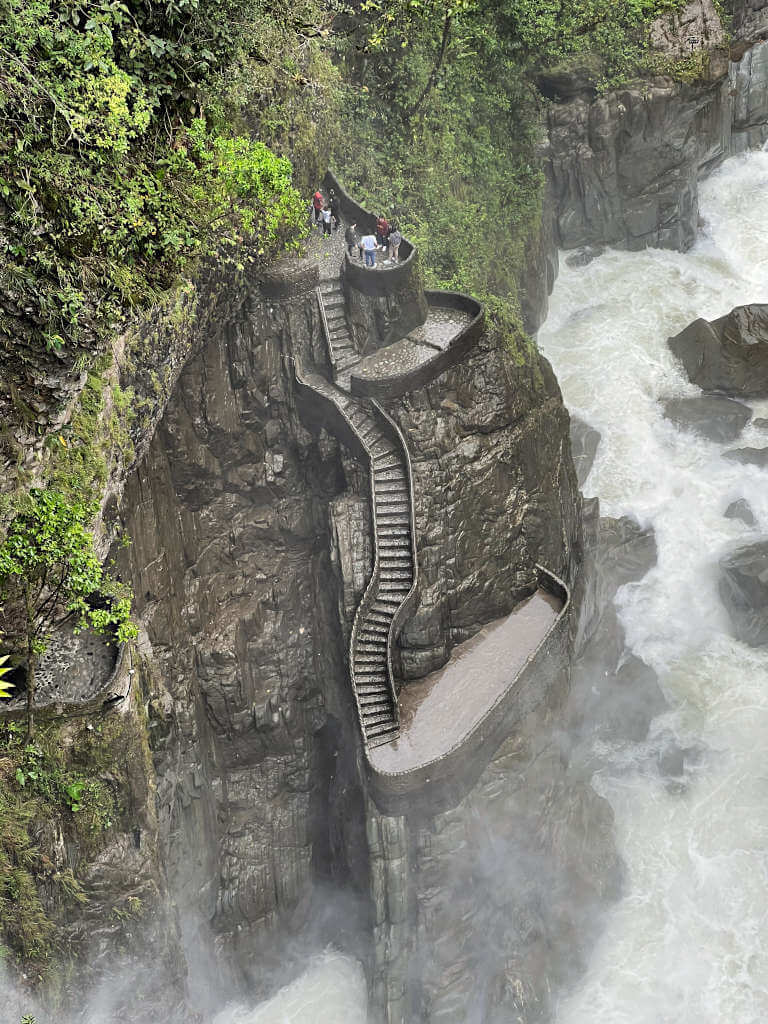
Cascada Pailón at Night
Devil’s Cauldron Waterfall is open well into the night, all week round. However, if you enter after dark, the entrance fee doubles.
But, for this extra cost, you do get treated to a unique sight. Brightly coloured lights illuminate the waterfall, the walkways and the rocks, bringing the whole cauldron to life.
Facilities on-Site
At the entrance, you’ll find toilets and a small kiosk selling snacks/drinks. There’s also a small seating area and places along the route where you can rest too.
Just outside the entrance are many restaurants, cafes and stores as well as stalls selling souvenirs. You can chain your bicycle up either in the town or near the waterfall entrance.
Parking is available at both entrances – typically for 1 USD.
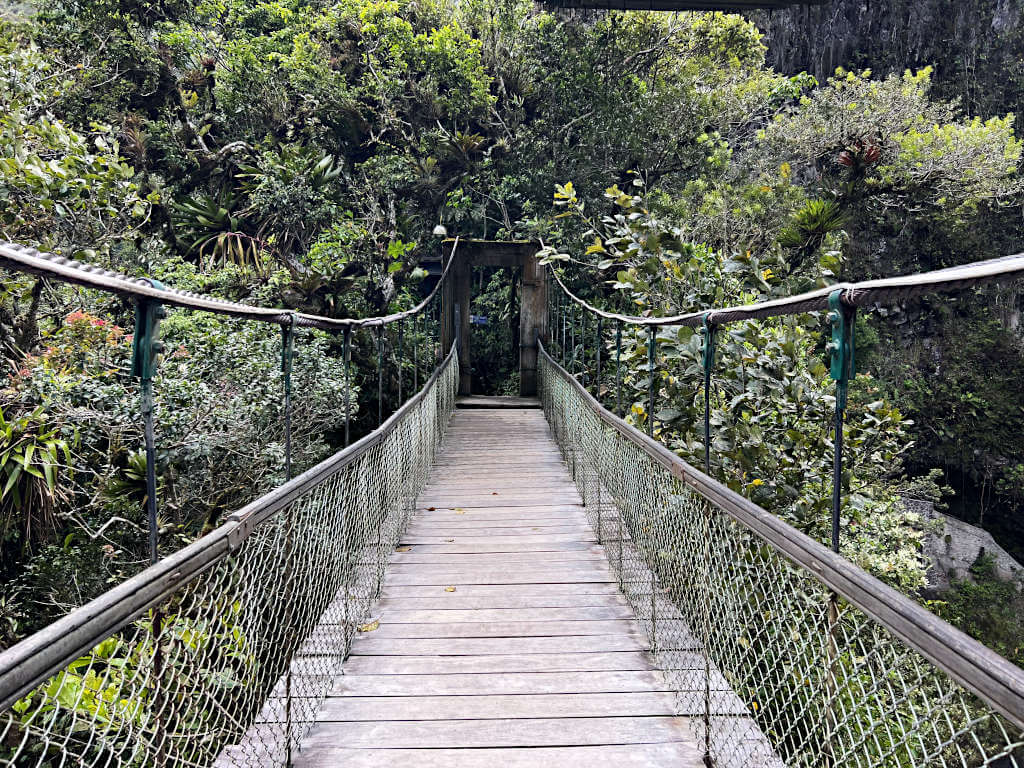
How do you get to Pailón del Diablo from Banos?
Bicycle
A popular activity in Baños is to hire a bicycle and cycle the Ruta de las Cascadas. Doing this, you can stop at 3 or 4 other waterfalls along the way, with the Devil’s Cauldron Waterfall typically visited last.
The cycling route is approximately 16 km one-way. It’s probably 90% downhill or flat, and mostly along the roads. The route also includes a few tunnels. But, cyclists aren’t allowed in most of these. Instead, there are separate routes around that are well-marked.
One-day bicycle hire typically costs 5 to 10 USD. This price should include a helmet, chain and lock and tyre pump. But, be sure to check when you need to return the bicycle, sometimes all day doesn’t quite mean that. And, cycling the Ruta de las Cascadas will likely take most of the day, especially if you stop to admire every waterfall.
Bus
Easier and quicker than cycling and at an even more bargain price, the bus is the ultimate budget option. From the terminal in Baños, take the bus towards Puyo and get off at Río Verde for the waterfall. The buses run every 20 to 30 minutes and cost 0.50 USD one way.
Taxi
A one-way taxi trip from Baños to the waterfall will likely cost around 10 USD – if you haggle hard. Otherwise, it can be up to 20 USD.
Because of this, it’s most cost-effective if you’re in a group and can split the costs. Plus, if you’re wanting the taxi to wait around and then take you back to Baños, you’ll need to pay more.
However, if you do get a taxi to the waterfall, there are trucks and buses than run back to Baños without stopping. See more information in the Getting Back to Baños section below.
Car
You’ll find well-maintained and easy to drive on roads between Baños and Río Verde, where the waterfall is located. From the centre of the city, expect the drive to take around 30 minutes.
Parking is available all around the waterfall – at the entrances and in the town – typically for 1 USD.
Tour
If you don’t fancy cycling but still want to see plenty of waterfalls on the Ruta de las Cascadas, bus tours are a great option. Take your pick from either double-decker or Chiva (open-sided) buses and ride to the waterfalls in style!
Pros include not having to cycle, focusing on stunning views the whole ride and getting a guide. Although, you’ll have less control over where you stop and for how long.
If you’re in Quito and short on time, these 1- and 2-day tours below are a great option. Prices generally include private transport, a guide and some even include all entrance fees.
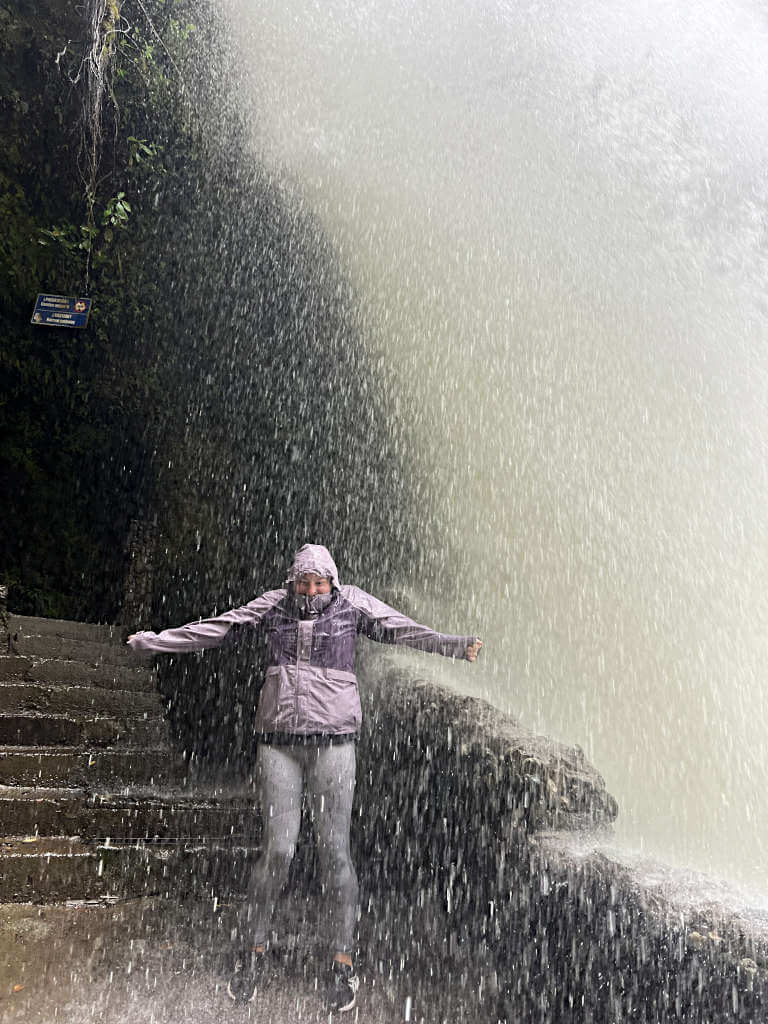
How to get back to Baños from the waterfall
If you’ve cycled to Diablo Waterfall, you’ll be happy to hear that getting back is much easier! For just 2.50 USD, you and your bike can take a ride in an open-backed truck back to Baños.
The trucks wait by the second entrance to the waterfall, just over the yellow bridge. They leave once there are 5 people. Although, you can pay extra to leave immediately – for example, if there are 2 of you, you’ll need to pay to make up for the 3 remaining seats.
Inside, you’ll find thin wooden benches that aren’t exactly comfortable. But, by this point in your day, they’ll feel far comfier than a bike seat!
If you haven’t rented a bike, instead you can hop on the local bus back to Baños for 0.50 USD. These run every 20 to 30 minutes coming from Puyo.
Do you have any questions or want any more information? If so, drop a comment below and I’ll get back to you!
Information is correct as of November 2022 but is subject to change in future.
More Travel Inspiration…
ECUADOR: Mitad del Mundo Ecuador: A Guide to Quito’s Equator Line
COLOMBIA: 11 Stunning Waterfalls in Colombia Worth Visiting
PERU: Laguna Paron: Ultimate Guide to Visiting from Caraz or Huaraz
COLOMBIA: Salento, Colombia: Ultimate Guide (Quindío’s Prettiest Town)
PERU: Laguna Churup, Huaraz: Independent Day Hike to 4500 metres
COLOMBIA: Cascada La Chorrera, Choachi: Colombia’s Tallest Waterfall (Complete Guide)
PIN IT FOR LATER!
